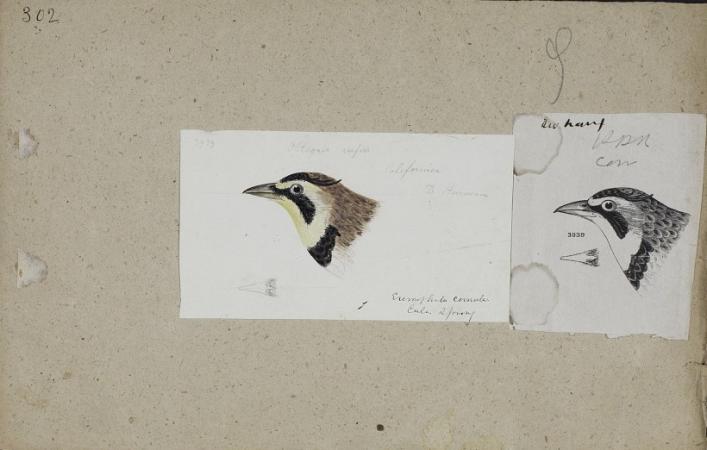As part of Smithsonian Open Access, digital visitors may now download, remix, and share more than 2,000 collection items from the Archives, including a number of bird head illustrations by Robert Ridgway.
In 1901, with eleven volumes and 6,000 pages, Robert Ridgway (1850–1929) published the authoritative work on bird systematics, The Birds of North and Middle America. In print for fifty years, this effort was the penultimate undertaking in his career that began in 1868, at age 17.
Ridgway was an early protégé of Spencer Fullerton Baird (1823-1887). Baird became acquainted with Ridgway in a roundabout way when, at thirteen years of age, Ridgway reached out for help in identifying a bird near his home. Baird, a distinguished ornithologist, identified the bird from the drawing Ridgway had sent, and a correspondence ensued in which Baird encouraged Ridgway to incorporate scientific classifications in his observations.
Baird must have been very impressed with the young man, because three years later he saw to it that Ridgway was appointed zoologist for the Survey of the 40th Parallel (1867-1881), led by geologist Clarence King. Ridgway spent two years with the expedition in northeastern California, Nevada, and Utah collecting specimens, including many birds, nests, and eggs, for the United States National Museum. In 1880, he became Smithsonian’s inaugural curator of the Department of Birds.

Getting it right …
Precision in classification was absolutely essential to Ridgway, Assistant Secretary Spencer Fullerton Baird, and other ornithologists of the time. Insistence on a high standard made identification of new species and their place in relationship to other species significantly less complicated. Nineteenth-century ornithologists would have wholeheartedly agreed with this present-day statement on the University of California Museum of Paleontology’s website:
“For biologists to communicate with each other about these many organisms, there must also be a classification of these organisms into groups. Ideally, the classification should be meaningful, and not arbitrary — it should be based on the evolutionary history of life, such that it predicts properties of newly discovered or poorly known organisms.”
… Leads to new discoveries
As head curator in the Department of Birds at the U.S. National Museum for half a century, Ridgway and his team’s records in and outside the Smithsonian are well documented in the Smithsonian Institution Archives’ U.S. National Museum Curators Annual Reports, 1881-1964 (Record Unit 158). Thousands of bird specimens were donated to the Museum in that period and the exactitude of his systematic classification unearthed many new species. To point out one example, the Hylocichla aliciae bicknelli, reported as new to the collection in his 1884 annual report to Spencer F. Baird, is known today as Catharus bicknelli (Bicknell’s thrush). Other new species appear in his 1889-90 annual report, in this instance, from the Straits of Magellan and the Galapagos Archipelago, before appearing in a separate paper in 1894.

Don’t Forget the Colors
For Robert Ridgway, precision was required not only in species and subspecies classification, but also in the colors used to depict them. The exceptional quality of his artistic illustrations, which first caught Spencer F. Baird’s eye in 1863, only grew in adulthood. Ridgway published two color studies to promote accurate and consistent use of coloring in the description of specimens.

Discovering A Multiplicity of Primary and Secondary Sources
Ridgway’s curatorial reports, personal field journals, sketches, illustrations, color studies, and contributions to the American Ornithological Union can be found at the Smithsonian Institution Archives. They document his work with specimens in the lab, in the field, and on the museum floor throughout his career. Over two hundred of his publications, articles, and papers have been digitized and contributed to the Biodiversity Heritage Library.
Related Collections
- Robert Ridgway Papers, 1850s-1919, Record Unit 7167, Smithsonian Institution Archives
- United States National Museum Curators' Annual Reports, 1881-1964, Record Unit 158, Smithsonian Institution Archives
- Robert Ridgway search results, Biodiversity Heritage Library
Produced by the Smithsonian Institution Archives. For copyright questions, please see the Terms of Use.

Leave a Comment